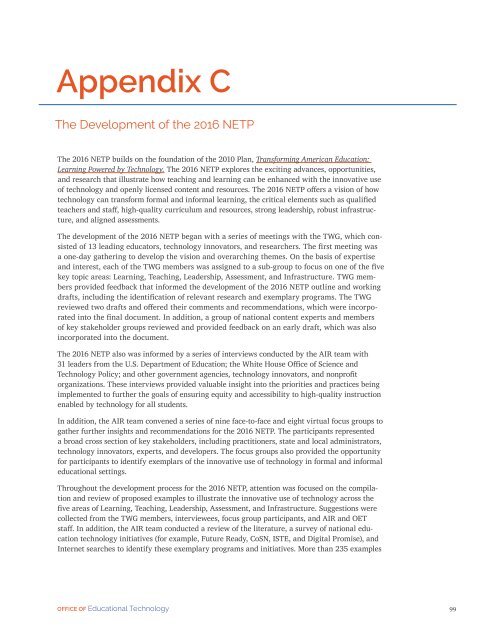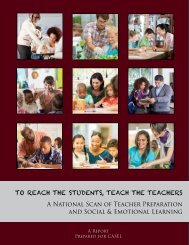Future Ready Learning
7m3sdJ
7m3sdJ
You also want an ePaper? Increase the reach of your titles
YUMPU automatically turns print PDFs into web optimized ePapers that Google loves.
Appendix C<br />
The Development of the 2016 NETP<br />
The 2016 NETP builds on the foundation of the 2010 Plan, Transforming American Education:<br />
<strong>Learning</strong> Powered by Technology. The 2016 NETP explores the exciting advances, opportunities,<br />
and research that illustrate how teaching and learning can be enhanced with the innovative use<br />
of technology and openly licensed content and resources. The 2016 NETP offers a vision of how<br />
technology can transform formal and informal learning, the critical elements such as qualified<br />
teachers and staff, high-quality curriculum and resources, strong leadership, robust infrastructure,<br />
and aligned assessments.<br />
The development of the 2016 NETP began with a series of meetings with the TWG, which consisted<br />
of 13 leading educators, technology innovators, and researchers. The first meeting was<br />
a one-day gathering to develop the vision and overarching themes. On the basis of expertise<br />
and interest, each of the TWG members was assigned to a sub-group to focus on one of the five<br />
key topic areas: <strong>Learning</strong>, Teaching, Leadership, Assessment, and Infrastructure. TWG members<br />
provided feedback that informed the development of the 2016 NETP outline and working<br />
drafts, including the identification of relevant research and exemplary programs. The TWG<br />
reviewed two drafts and offered their comments and recommendations, which were incorporated<br />
into the final document. In addition, a group of national content experts and members<br />
of key stakeholder groups reviewed and provided feedback on an early draft, which was also<br />
incorporated into the document.<br />
The 2016 NETP also was informed by a series of interviews conducted by the AIR team with<br />
31 leaders from the U.S. Department of Education; the White House Office of Science and<br />
Technology Policy; and other government agencies, technology innovators, and nonprofit<br />
organizations. These interviews provided valuable insight into the priorities and practices being<br />
implemented to further the goals of ensuring equity and accessibility to high-quality instruction<br />
enabled by technology for all students.<br />
In addition, the AIR team convened a series of nine face-to-face and eight virtual focus groups to<br />
gather further insights and recommendations for the 2016 NETP. The participants represented<br />
a broad cross section of key stakeholders, including practitioners, state and local administrators,<br />
technology innovators, experts, and developers. The focus groups also provided the opportunity<br />
for participants to identify exemplars of the innovative use of technology in formal and informal<br />
educational settings.<br />
Throughout the development process for the 2016 NETP, attention was focused on the compilation<br />
and review of proposed examples to illustrate the innovative use of technology across the<br />
five areas of <strong>Learning</strong>, Teaching, Leadership, Assessment, and Infrastructure. Suggestions were<br />
collected from the TWG members, interviewees, focus group participants, and AIR and OET<br />
staff. In addition, the AIR team conducted a review of the literature, a survey of national education<br />
technology initiatives (for example, <strong>Future</strong> <strong>Ready</strong>, CoSN, ISTE, and Digital Promise), and<br />
Internet searches to identify these exemplary programs and initiatives. More than 235 examples<br />
OFFICE OF Educational Technology<br />
99



